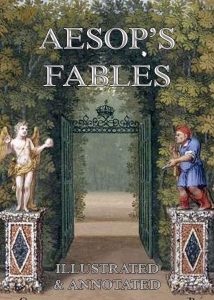Aesop’s Fables – Aesop
The habit of telling stories is one of the most primitive characteristics of the human race. The most ancient civilizations, the most barbarous savages, of whom we have any knowledge have yielded to investigators clear traces of the possession of this practise, The specimens of their narrative that have been gathered from all the ends of the earth and from the remotest times of which we have written record show traces of purpose, now religious and didactic, now patriotic and political; but behind or beside the purpose one can discern the permanent human delight in the story for its own sake. The Æsopic Fables are allegorical tales. The form of the old animistic story is used without any belief in the identity of the personalities of men and animals, but with a conscious double meaning and for the purpose of teaching a lesson. The fable is a product not of the folk but of the learned; and though at times it has been handed down by word of mouth, it is really a literary form.
Format: Paperback.
Aesop’s Fables.
ISBN: 9783849687069
Available at amazon.com and other venues.
Basics on Aesop’s Fables (from Wikipedia):
Aesop’s Fables or the Aesopica is a collection of fables credited to Aesop, a slave and storyteller believed to have lived in ancient Greece between 620 and 564 BCE. Of diverse origins, the stories associated with his name have descended to modern times through a number of sources and continue to be reinterpreted in different verbal registers and in popular as well as artistic media.
The fables originally belonged to the oral tradition and were not collected for some three centuries after Aesop’s death. By that time a variety of other stories, jokes and proverbs were being ascribed to him, although some of that material was from sources earlier than him or came from beyond the Greek cultural sphere. The process of inclusion has continued until the present, with some of the fables unrecorded before the later Middle Ages and others arriving from outside Europe. The process is continuous and new stories are still being added to the Aesop corpus, even when they are demonstrably more recent work and sometimes from known authors.
Manuscripts in Latin and Greek were important avenues of transmission, although poetical treatments in European vernaculars eventually formed another. On the arrival of printing, collections of Aesop’s fables were among the earliest books in a variety of languages. Through the means of later collections, and translations or adaptations of them, Aesop’s reputation as a fabulist was transmitted throughout the world.
Initially the fables were addressed to adults and covered religious, social and political themes. They were also put to use as ethical guides and from the Renaissance onwards were particularly used for the education of children. Their ethical dimension was reinforced in the adult world through depiction in sculpture, painting and other illustrative means, as well as adaptation to drama and song. In addition, there have been reinterpretations of the meaning of fables and changes in emphasis over time.
(The text of the last section was taken from a Wikipedia entry and is available under the Creative Commons Attribution-ShareAlike License.)
Publisher’s Note: This book is printed and distributed by Createspace a DBA of On-Demand Publishing LLC and is typically not available anywhere else than in stores owned and operated by Amazon or Createspace.

